Situated on Potsdamer Straße among galleries like Krome and Thomas Fischer is the bright, young face of LSD Galerie. But LSD is not like its nearby counterparts; it marks the beginning of a growing trend in galleries adopting artist-run models. Opening just last year, the gallery is the product of eight artists’ desire to create a self-directed platform to present and market their and other artist’s works.
Since then, two managers were taken on board to help run the gallery–– Gianni Hilgemann and Wayra Schübel. Hilgemann combines a long family tradition of collecting and marketing art with personal experience in managing his own gallery, while Schübel brings a unique background in Chinese studies and IT before working as a freelance curator and journalist for artists and artist initiatives. We sat down with the pair to discuss this unique gallery concept and the different dynamics that come with it.
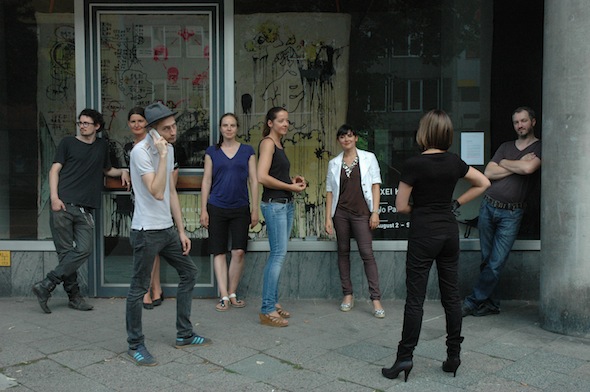 From left to right: Moritz Stumm, Anna Lehmann-Brauns, Gianni Hilgemann, Sabine Dehnel, Anneke Eussen, Wayra Schübel, Viola Kamp, Peter Freitag
From left to right: Moritz Stumm, Anna Lehmann-Brauns, Gianni Hilgemann, Sabine Dehnel, Anneke Eussen, Wayra Schübel, Viola Kamp, Peter Freitag
BERLIN ART LINK: LSD is a different kind of gallery, started by the artists who are represented. Would you call it a Produzentengalerie?
GIANNI HILGEMANN: Although started by artists, it is not run by artists. It is more of a mixed form, a cooperative. Financially supported by the group of artists that started it.
WAYRA SCHÜBEL: It is a space initiated by artists, in cooperation with us as managers. As a gallery form, it is somewhere between this artist-run space and the classical gallery model in search for a sustainable new concept. The classical gallery form is dying; there are a lot of closings in the middle-field worldwide. Emphasis is moving towards the big galleries and auctions, while the others are having trouble surviving.
GH: It is almost impossible to build up an emerging artist in a small-scale, or middle-scale gallery today, because the market has diminished but the costs for everything are staying the same. You have to really search for alternatives.
So what are the differences that separate LSD from the classical gallery model?
GH: The artists came up with the idea and gave a lot of their own energy to create the base. Also, when the artists decide, there is more room for experimentation. In a traditional gallery, the gallery owner or director makes the decision. This is usually based on what is feasible, so it really becomes a decision based on market and price.
WS: For every exhibition at LSD, we are all talking with each other throughout the process. We are ten people, not one gallerist. This brings together ten networks–– an advantage of this gallery.
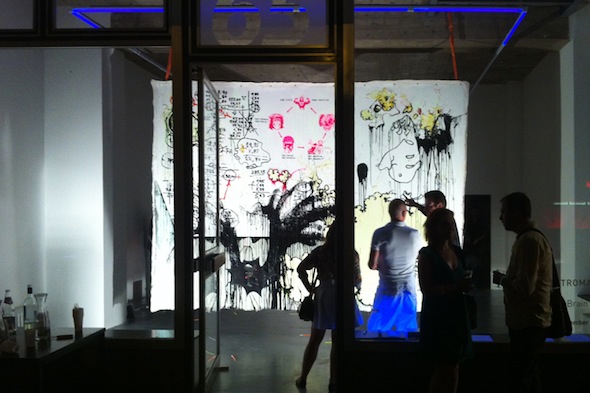 Alexei Kostroma, No Pain No Brain, 2013, installation view current exhibition at LSD Galerie Berlin
Alexei Kostroma, No Pain No Brain, 2013, installation view current exhibition at LSD Galerie Berlin
Exactly. What are some other advantages or disadvantages to your gallery system?
GH: It’s first and foremost the space, this space was already prepared by the artists. You cannot beat the location, Potsdamer Strasse.
WS: And of course, learning from the artists and their professional experience is a unique advantage.
GH: And I think they learn from my gallery experience, everything from pricing to strategies.
WS: We are very inspired by the group, and by each other. It is a cooperative system represented in a cooperative spirit.
GH: Having two managers means we can divide tensions between us.
WS: Another advantage is that we, as well as all artists who founded LSD Gallery were on a mid-career level, they were not fresh out of art school.
And difficulties?
GH: Certain decisions take longer with more people.
How is such a big group of people managed, how does it work?
GH: There is no one who has the last say. Most things are democratically decided, such as deciding on an artist.
WS: But of course, for the simple decisions, it’s easier to have just one person deciding…
GH: For the more technical matters or the bank accounts management, these things are separated among individuals or else it would become too slow.
How did this all begin? Which artists had the original idea and why did they begin this kind of gallery?
WS: Well, the gallery is very young, it started September of last year. The decision of the artists to build up their own platform is approximately even a year older. That group consisted of three artists: Anna Lehmann-Brauns, Sabine Dehnel, Peter Freitag. They gradually invited the others to join them to complete the group.
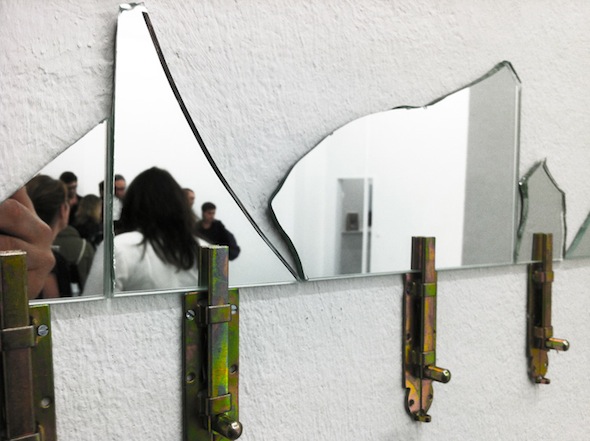 Anneke Eussen, NEUBAU Stuck, 2013, installation view at LSD Galerie Berlin
Anneke Eussen, NEUBAU Stuck, 2013, installation view at LSD Galerie Berlin
And when did they hire you?
GH: I was asked to join at the start, around the time of the first opening. The artists knew I had a gallery before, so I know the classical gallery through and through, and I wanted another non-artist to be on the team, to make decisions on certain matters from a non-artistic view.
WS: In October, I was asked by Peter Freitag if I could replace Gianni temporarily at the gallery while he was not in Berlin. Since 2007 I have represented various artist-run projects, so the idea appealed to me. When I met Gianni, and he expressed he didn’t want to manage it alone, I said, “Why temporary? Let’s do it together.”
When you had your own gallery, it was your own risk when you didn’t sell. Now the risk is shared; these artists employ you. Is there more pressure with this?
GH: I think the pressure is pretty much the same. My nature is to deliver hurray’s. I want to deliver sales no matter what. Anyway, the main part of our payment should come from the sales, so that risk is still there.
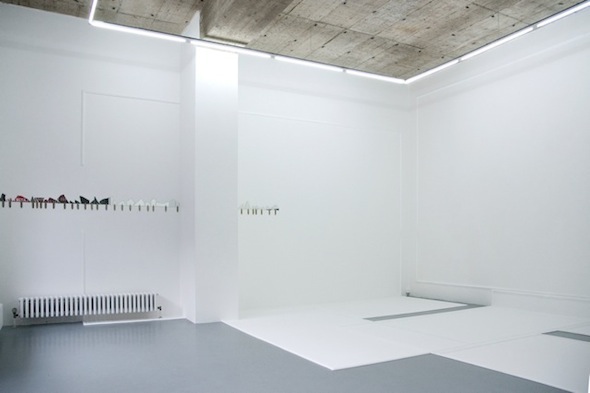 Anneke Eussen, NEUBAU Stuck, 2013, installation view at LSD Galerie Berlin
Anneke Eussen, NEUBAU Stuck, 2013, installation view at LSD Galerie Berlin
LSD is a kind of “trial” for a new business model: the moving away from the traditional, fifty-fifty model of classical galleries into one where costs are held by the artist. What do you think about this traditional system, and would you say the one of LSD is better?
GH: The new model is one where the artist understands the value of all the labour involved, and understand this is necessary to make success possible. So if an artists says, “hey, I can pay my rent with only twenty percent of my sales, that means I can re-invest eighty percent into making things better, like using better quality materials or send out more professional e-mailings.” If you look at a value and what is necessary to push this value upwards, and yet still insist on fifty percent, you might be making improvements impossible.
WS: With this fifty percent, artists are stuck in a kind rule of thumbs that only works in their minds. You can see it progressing, but you can hardly find examples of galleries working in any other way yet, most are too traditionally bound. There are still a lot of questions concerning the best alternative to the classical gallery model, such as who is the one who has to finance this creative outcome? It is still in an experimental phase in the gallery world.
GH: Quoting Annet Gelink, a big gallery in Amsterdam that does a lot of art fairs. “I am forced to only show my successful artists at art fairs, because a new artist fresh from art school does not have the price level and collectors base required to take such a risk. I would have to ask 80% from struggling young artists.”
I interpreted this that somehow I have to pay for the fair, which costs, let’s just say, twenty thousand euros. So I have to make forty sixty thousand euros at the art fair; you’re not going to make sixty thousand at the art fair with an emerging artist, who also has this fifty percent number set in stone in their head. So, the classical system essentially makes it impossible to bring new, young artists onto the scene without having a very large investment budget.
WS: At LSD, we are happy that the costs are not only held by the artists at the moment. We had really good income from collectors already.
GH: I think this gallery has already made a bigger turnover than the first year of my gallery, in 2006, even before the financial crisis. That is a result of the cooperative, of different networks coming together.
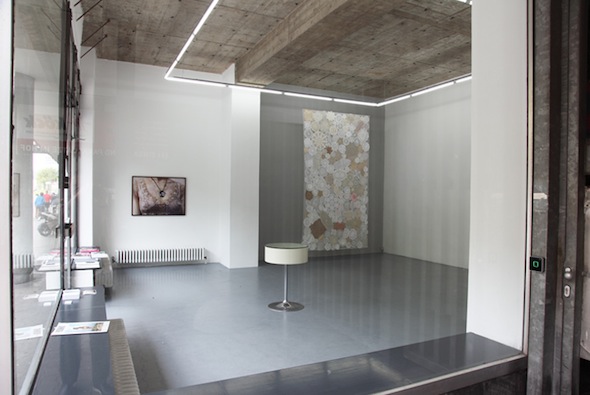
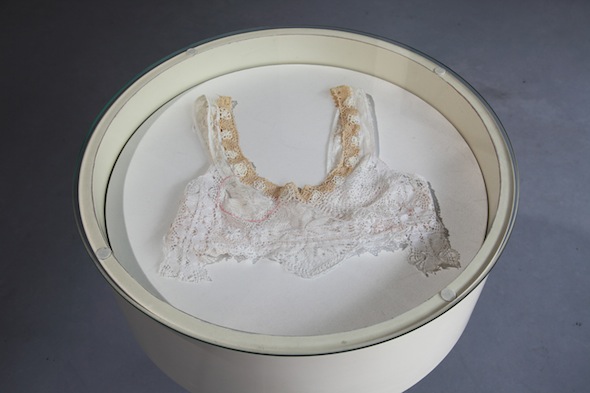 Sabine Dehnel, Drop The Thought, 2013, installation view at LSD Galerie Berlin
Sabine Dehnel, Drop The Thought, 2013, installation view at LSD Galerie Berlin
Do you think you’ll do an art fair in the future?
GH: We did an art fair at the start, and will do it again. But it is not on the top of the list at the moment, because we don’t have a clear picture of what is the right kind of fair.
WS: Art fairs as a market place have changed a lot in the last twenty years and are still changing. So this decision is a really important one: To build up a good network, once you participate in an art fair, you should participate regularly.
But isn’t this the best way to sell the works internationally? To build up international clientele?
WS: Berlin is a really international place, and we are situated in a location with other galleries already drawing in clients from all over the world. They are coming here, to Potsdamer Strasse.
GH: Also, Berlin is one of the cities where gallery weekends really work. This is almost an alternative to an art fair.
How do artists act differently at LSD, as compared to artists you experienced in traditionally run galleries?
WS: It is too early to say. But the most obvious thing is that artists here are pro-active, they are really willing to engage.
GH: And they don’t expect that the gallery has a big pot of gold and will be able to cover all the costs. They see all the costs, and they accept them.
WS: Also, the artists have to have a different way of thinking about the content, or about the program. The traditional concept of an artist working with a classical gallery limits the part of the work they do to their studio on the production side, and leaves the rest up to the gallerist. But the moment you are part of a collective like LSD, you are automatically co-curating all activities.
 Lucy in the Sky with Diamonds, Inaugural Group Show, 2012, installation view at LSD Galerie
Lucy in the Sky with Diamonds, Inaugural Group Show, 2012, installation view at LSD Galerie
Do new artists that you exhibit then become part of the collective, part of the decision-making, and take on this financial burden?
GH: There are the artists who are active, and they also take financial responsibility. Then we have invited artists, like the one for the next show.
Is there a connection between the artists? They appear to work in extremely different ways and styles. Is this what is guiding you when looking for new artists to take on?
GH: No, it is the human level first. Interaction. Then it is the network. As a gallery manager, I am not in favor of having an artist who makes similar work; it is totally futile.
WS: Exactly, it is the human level. They all have different ways of working, but they all have something together, which is not a specific topic, but the way of looking at life, at social and political subjects.
GH: My mother runs a gallery, and she says it like this: “A gallery is purely relationships. The artwork merely is a connector that links, or a fuse that sparks those relationships.” On the side of selecting artists and finding clients, it is about working with human beings. Art is one of the few niches in society where there are few boundaries, allowing you to sit down at the table with people you would normally never meet.
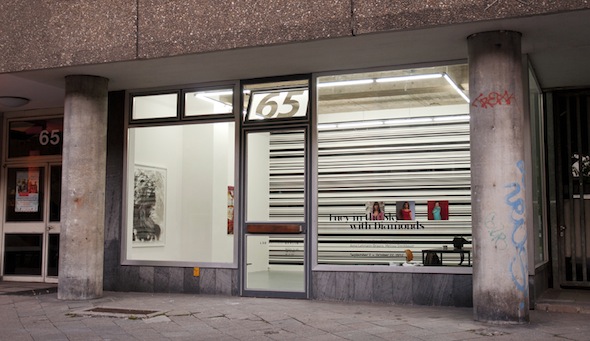 Lucy in the Sky with Diamonds, Inaugural Group Show, 2012, installation view at LSD Galerie
Lucy in the Sky with Diamonds, Inaugural Group Show, 2012, installation view at LSD Galerie
Writer Info
Sarah Gretsch is living in Germany since January 2012. Originally from the United States, where she pursued her Bachelor’s in Art history, she is now continuing her studies in Berlin.

























